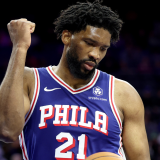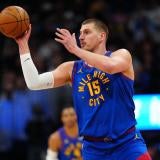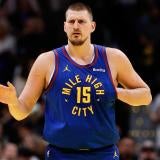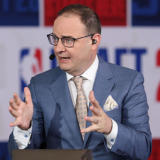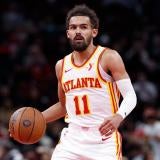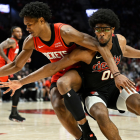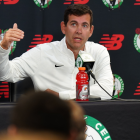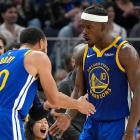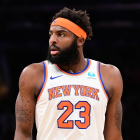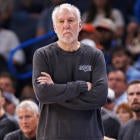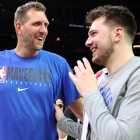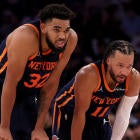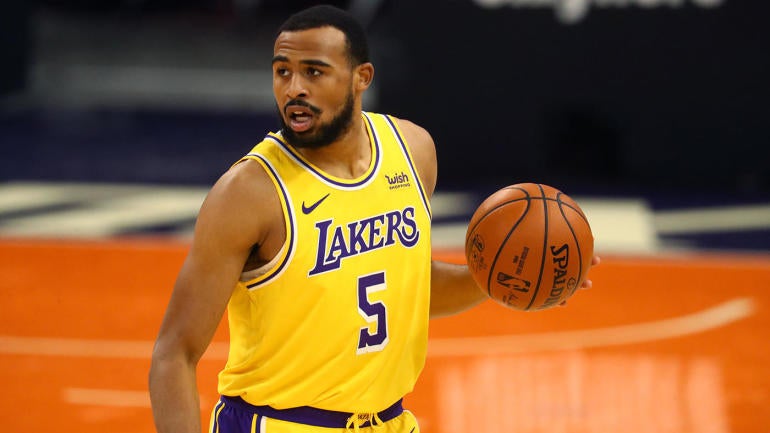
Cap space is hoarded on expectation. Offseasons in which it is sparse usually come on the heels of a leaguewide expectation that there won't be anyone worth spending it on. But when a group of superstars is set to hit the market? Teams prepare for that years in advance. They did so for Giannis Antetokounmpo, LeBron James, Paul George and Rudy Gobert in 2021. All four of them signed contract extensions prior to the 2020-21 season.
But that cap space still exists. Almost half of the league will have more than the mid-level exception to spend, many more will approach max space, and some of those teams face a ticking clock in spending their space before they lose it. History says that it is going to get spent even if the players teams hoped to spend it on are gone. Vacuums exist to be filled. One of the primary questions entering the 2020-21 season was who would emerge to fill this one.
We're three weeks into the campaign, but are starting to get an idea. A thin class lacking in star power is starting to yield some heavy hitters. So with the first 10 games or so in the books, who has taken advantage of the opportunity those re-signed superstars created and made themselves money ahead of 2021's spending spree?
Victor Oladipo
Trade rumors surrounded Oladipo throughout the 2020 offseason, but the lack of any firmly-reported offers suggested justifiably tepid league-wide interest before Houston swooped in and nabbed him as part of the James Harden blockbuster. His performance after over a year spent recovering for a ruptured quad tendon was perhaps the worst of his career, producing career-lows in field goal percentage, steals, blocks and rebounds and coming close in points and assists. The obvious takeaway was that Oladipo, optimized as a lead ball-handler, had lost his explosiveness and couldn't compensate with improvement elsewhere.
Well, here's where things get interesting, because Oladipo has managed to elevate another key part of his game, but he's done so with his explosiveness surprisingly intact. This guy can still move.
Oladipo hasn't been as efficient near the basket as he was at his peak, but he's getting to the rim even more often than he did in his first season in Indiana. Where he has impressed most this season, though, is off the ball. He is taking 3.3 catch-and-shoot 3-pointers per game -- his highest total since leaving the Thunder -- and making 46.2 percent of them. It's a small sample size across only eight games, but the volume is as meaningful as the percentage. The All-NBA version of Oladipo used 48 percent of his possessions on pick-and-rolls and isolations. This season? He's down to 36.4 percent, yet he's still managed to score at an All-Star level.
This matters on a number of levels. It provides a measure of insurance against future injuries to Oladipo, for example, but it also makes him a more comfortable fit alongside the sort of players whose teams will be recruiting him. The Oladipo who became a star in 2018 needed the ball in his hands to reach those heights. The 2021 incarnation is a bit more flexible. Lineups featuring Oladipo and Indiana's co-lead ball-handler Malcolm Brogdon scored a strong 115.9 points per 100 possessions so far this season, per Cleaning the Glass. Houston is hoping that he and John Wall can find similar success.
That's reassuring to, say, Jimmy Butler's Miami Heat or Luka Doncic's Dallas Mavericks. If those teams are going to break the bank to add Oladipo -- and, barring another injury, they'll have to -- they'll feel better knowing that he can function in a more nuanced role than Indiana's 2018 "let Victor create everything" offense allowed for. That was hardly a guarantee after either his disastrous apprenticeship under Russell Westbrook in Oklahoma City and his rise to stardom as, frankly, a dribbler. This might not be the best Oladipo, but it's quickly becoming the most complete one on offense, and that is going to generate the interest that was seemingly missing on the trade market last offseason.
In fact, the trade he was just a part of will only help him secure a long-term deal. The Rockets tipped their interest by trading for him in the first place. If they let him walk in the offseason, they will have effectively given away Caris LeVert for free. The Ringer's Kevin O'Connor reported that Oladipo still hopes to land with the Heat, but thanks to his Bird Rights, the Rockets can offer far more money. They might have to considering his long-reported interest in the Heat. It's the best of both worlds for Oladipo. He could either secure an enormous financial commitment from the Rockets, or land with the Heat as he reportedly desires.
Tim Hardaway Jr.
Hardaway landed in Dallas as a throw-in. The Mavericks took on his contract as the price of acquiring Kristaps Porzingis'. They were pleasantly surprised to find that he'd become a useful starter on last season's playoff run, but for a team with loftier long-term ambitions, he appeared destined to become a footnote. His contract is set to expire after the season, and the 2021 bonanza was supposed to get Dallas the superstar free agent it has so often missed on. It could hardly ask for a better recruiter than Doncic.
But most of those stars are gone, and the ones that will be available, like Oladipo, will generate stiff competition. In a world in which they can't add the tertiary All-Star of their dreams, retaining Hardaway is becoming a more and more appealing consolation prize with each passing game.
Hardaway arrived in Dallas as a below-average shooter, and his first few months as a Maverick saw him make only slightly more than 32 percent of his long-range attempts. That made last season's push for 40 percent somewhat untrustworthy. Rick Carlisle is the king of the outlier, and investing in his mirages is foolhardy for a team that can feel comfortable in its ability to produce more of them. But so far in 2021, Hardaway has vastly outshot even his unsustainable 2020 numbers. Not only is he making almost 44 percent of his 3-pointers, but he's taking 8.9 of them per game. Klay Thompson has never taken that many over a full season.
Should that shooting sustain, it offers a meaningful counterbalance to a number of existing forces within Dallas' lineup structure. If they need to start Dorian Finney-Smith to get by defensively? Hardaway makes that easier to stomach offensively. He and Josh Richardson both shoot and dribble well enough for Dallas to tilt game-plans depending on matchups. That malleability will make it easier for Carlisle to tinker with lineup structures once he's seen how Porzingis fits with the newer Mavericks.
Dallas can get to max space a number of different ways, but the easiest would be letting Richardson walk after opting out. Should they choose to operate above the cap, they could retain him, Hardaway and spend the full mid-level exception without offloading another contract. Max space would've been worth those three players when it could've netted the Mavericks Giannis. If Oladipo is the top prize? Why bother? The Mavericks can keep their core together, add another piece, and retain enough salary ballast to make a big trade later if one presents itself. Hardaway's contract was once viewed as so toxic that the Knicks were willing to trade Porzingis to get off of it. He's redeemed himself so fully in Dallas that the Mavericks might be best-served by giving him another one.
Mike Conley
Few players have ever been asked to make as enormous a systematic adjustment as Mike Conley did last season. He went from a Memphis roster that never took 3-pointers to a Jazz team that signed Bojan Bogdanovic specifically to boost their long-range numbers. He went from the orchestrator of the Memphis offense to, at best, a sidekick to Donovan Mitchell. And then there was his pick-and-roll partnership. After a career spent alongside the ground-bound Marc Gasol, it took months to develop any chemistry with Rudy Gobert, one of the NBA's great lob threats. That instinctual desire to leave a pocket pass for his partner at the nail derailed many a 2019-20 possession.
Time was all Conley needed. That hesitation is gone now, and the signs were there dating back to the Orlando bubble. Conley knows how to function alongside Gobert, and it's showing statistically across the board.
| 2019-20 | 2020-21 | |
|---|---|---|
Pick-and-Roll points per possessions (scoring only) | 0.841 | 1.012 |
Pick-and-Roll points per possessions (including passes) | 0.932 | 0.954 |
Field goal percentage | 40.9 | 45.2 |
3-Point Percentage | 37.5 | 43 |
Assists per game | 4.4 | 5.6 |
Conley will almost certainly remain with the Jazz beyond this season. Expensive veterans in their mid-30s rarely leave winning teams without taking massive pay cuts. But the comfort Conley has developed in Utah's somewhat more traditional infrastructure made him more desirable leaguewide because most centers play like Gobert offensively. The complicated two-man dance he developed with Gasol worked, but it was an anomaly he is unlikely to repeat. Not only has Conley reassured the Jazz that he can fit alongside Mitchell, but he's created a bit of a market for himself if he needs to generate any leverage financially. Not too shabby considering how washed up he looked at points last season.
Jarrett Allen
There's one every year. Some third-year first-round pick receives only a low-ball extension offer, bets on himself, and cashes in as a restricted free agent the following summer. The early favorite is Jarrett Allen, so undervalued by the Nets that he started the season coming off of the bench. That lasted seven games. Before he was traded Wednesday, the Nets were 11.9 points better per 100 possessions with Allen on the floor than on the bench, and nine points worse per 100 possessions with DeAndre Jordan in the game. Jordan's friendship with Kevin Durant and Kyrie Irving aside, Allen stood out as Brooklyn's superior center prior to becoming a casualty of its James Harden pursuit.
Allen has manhandled opponents physically so far, averaging career-highs in rebounds and blocks, yet he's done so in a more disciplined fashion by averaging a career-low in fouls. He was one of the primary beneficiaries of Brooklyn's improved spacing as well, shooting 69.5 percent from the field so far this season. Virtually every measure of effectiveness pegs him as a high-level starter for the long haul.
And that, in all likelihood, is why the Cavaliers traded for him. Andre Drummond is 27 and in need of a new contract. JaVale McGee and Kevin Love are both 32. Cleveland's youth is concentrated almost entirely in the backcourt, but in Allen, the Cavs have found a long-term rim-runner for Collin Sexton and Darius Garland in the pick-and-roll as well as a defensive anchor for a team that, while significantly improved, finished dead last on defense in each of the past two seasons. Barring something unexpected, Cleveland will likely either trade Drummond at the deadline or let him walk in the offseason, clearing the way for Allen to get paid and grow with the rest of the young Cavs roster.
Talen Horton-Tucker
Few teams have access to readymade stars in free agency. The rest have to seek out high-risk targets if they're hoping for a high-reward outcome. The Detroit Pistons looked crazy for giving Jerami Grant $60 million. Now he's averaging 25 points per game. Circumstance always manages to hold a few players back from realizing their full potential. One of this season's biggest breakout candidates has barely been able to find the floor.
Talen Horton-Tucker has played only 16.7 minutes per game this season, and when the Lakers are at full strength, there are going to be nights when he doesn't play at all. That's the downside to growing up on a contender. Horton-Tucker already has one DNP-CD. There will be more, through no fault of his own. But the flashes are there. There aren't many 20-year-olds splitting doubles and finishing in traffic like this.
Or making passes like this.
Being a Laker prohibits Horton-Tucker from doing this consistently, but his per-36 numbers are starter-quality. He's scoring roughly as much on a per-minute basis as Dennis Schroder, and while the preseason is hardly representative, 33-point outings aren't exactly something to scoff at. Some team is going to view that as a realistic and sustainable outcome just as Detroit saw that upside in Grant. Heavy's Sean Deveney reports that the Mavericks, Knicks and Cavaliers are possibilities.
The Lakers likely view Horton-Tucker as an integral part of their post-LeBron future. They aren't in any real danger of losing him, either. He's a restricted free agent, and they will almost certainly exercise their right to match any offer sheet. But rivals can make life difficult for them thanks to a CBA quirk known as the Gilbert Arenas provision.
The rule exists in large part to protect teams like the Lakers who have restricted free agents with only two years of experience, and therefore Early Bird Rights rather than full Bird Rights. It prevents rival teams from offering more than the non-taxpayer mid-level exception in the first year of the deal, and then limits them to a five percent raise in the second. This is done to ensure that rivals cannot hand out offer sheets that the original team cannot legally match. The catch? The third-year salary on these deals can jump up to the max, and the fourth year can get a five percent raise on top of that.
Put more simply, Horton-Tucker is eligible for an $80 million deal, but over $60 million of it would be paid out in the final two years. Here is the format of that enormous possible offer sheet based on the projected 2021-22 cap, laid out by Bleacher Report's Eric Pincus.
| Year | Salary |
|---|---|
2021-22 | $9,536,000 |
2022-23 | $10,012,800 |
2023-24 | $30,913,850 |
2024-25 | $32,304,973 |
Total | $82,767,623 |
From a cap perspective, teams have the option of structuring the arrangement in the above fashion, or by paying the average of the total contractual salary in each of the four seasons, but it can only make that choice if it is below the cap at the time of signing. If it isn't? The above structure, balloon payments and all, must be used. In other words, other teams could sign Horton-Tucker for this amount and take a manageable hit across all four seasons. The Lakers, who will be far above the cap next offseason, could not. They'd be dealing with two enormously expensive seasons.
The only cost of such a contract would be money, but it would take a considerable amount of it to keep this team together. Remember, LeBron James and Anthony Davis are both making the max, Kyle Kuzma and Kentavious Caldwell-Pope already have long-term deals, and Alex Caruso, Dennis Schroder, Montrezl Harrell, Markieff Morris and Wes Matthews are all free agents after the season. The Lakers have never shied away from the luxury tax, but this has the potential to become one of the most expensive rosters in NBA history if Horton-Tucker does indeed get that much.
Opposing teams know that. If they want to steal Horton-Tucker, making this sort of offer might be what it takes to scare the Lakers off even if he isn't worth it. Chances at 20-year-olds with his upside are rare. Someone is going to try to take it.
![[object Object] Logo](https://sportshub.cbsistatic.com/i/2020/04/22/e9ceb731-8b3f-4c60-98fe-090ab66a2997/screen-shot-2020-04-22-at-11-04-56-am.png)


